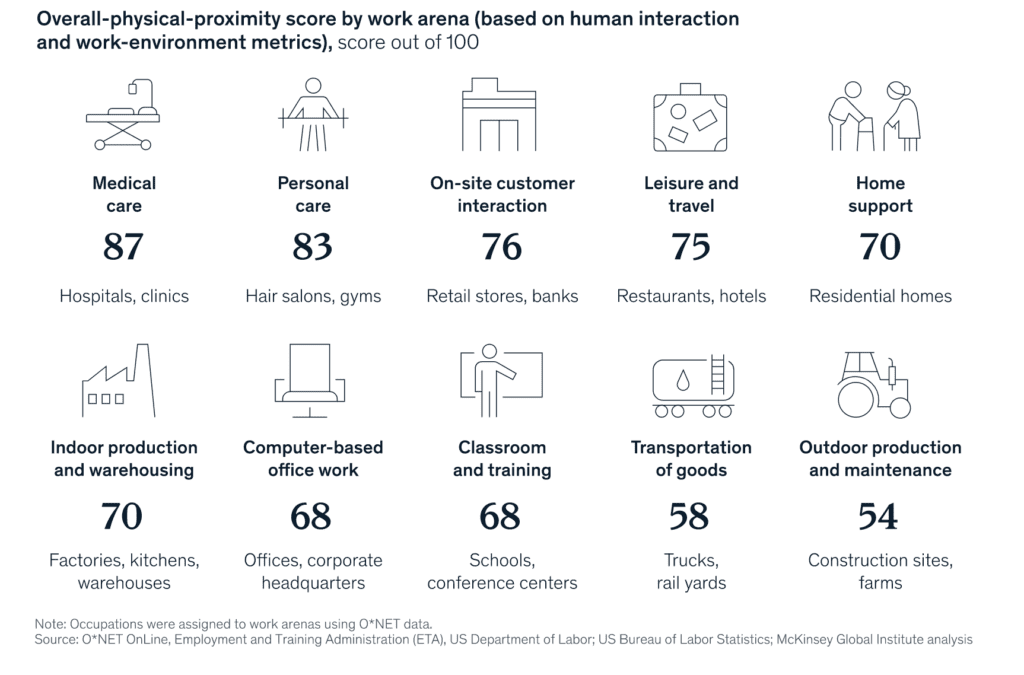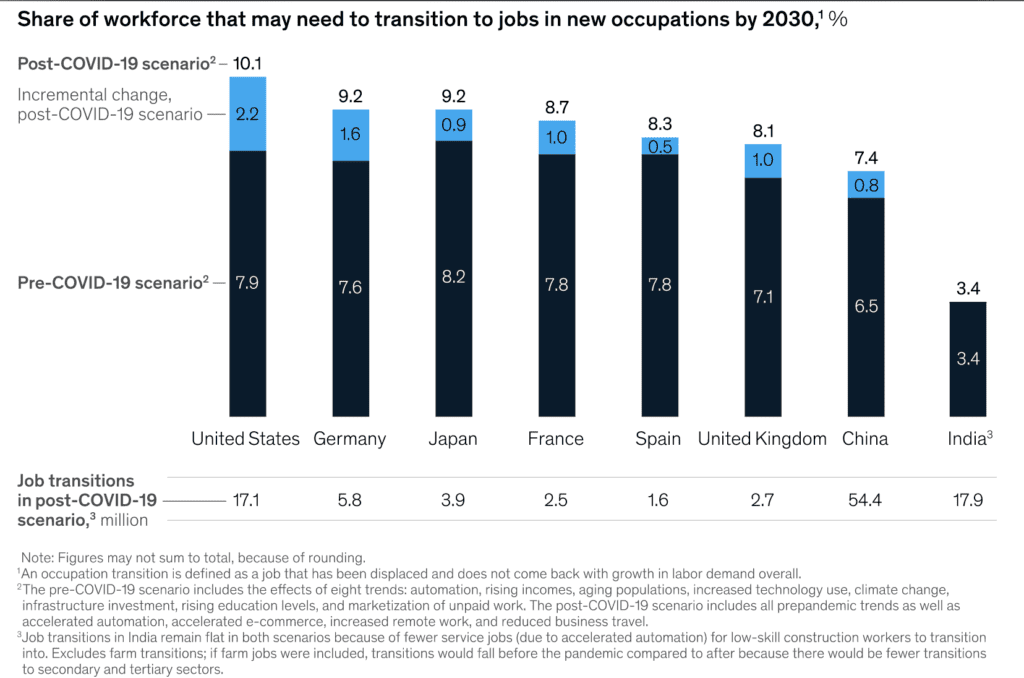McKinsey Report: COVID-19 to supercharge adoption of AI
The pandemic may boost the need to implement technologies such as AI and automation at speed.
Why You Should Care
The pandemic may boost the need to implement technologies such as AI and automation at speed.
The long-term effects of COVID-19 on labor forces across the globe.
Why HR teams need to begin planning for the incoming wave of change — NOW.
AI and automation are coming — the key question is: how can HR teams and organizations adapt to accommodate this incoming wave of transformation?
The COVID-19 pandemic may propel faster adoption of technologies such as automation and AI in offices — meaning HR technologists will likely have to speed up their future proofing strategies.
McKinsey Global Institutes’ ‘The Future of Work After COVID-19‘ report also found that the technologies could prove particularly useful in work arenas with high physical proximity.

“Two ways businesses historically have controlled cost and mitigated uncertainty during recessions are by adopting automation and redesigning work processes, which reduce the share of jobs involving mainly routine tasks,” the report reads.
McKinsey’s global survey of 800 senior executives found that two-thirds were stepping up investment in automation and AI, either somewhat or significantly.
“Many companies deployed automation and AI in warehouses, grocery stores, call centers, and manufacturing plants to reduce workplace density and cope with surges in demand. The common feature of these automation use cases is their correlation with high scores on physical proximity, and our research finds the work arenas with high levels of human interaction are likely to see the greatest acceleration in adoption of automation and AI,” adds the report.
The potential rise in adoption should come as no surprise to those in the HR industry as both artificial intelligence and automation can be leveraged to unlock efficiencies across the entire human resources cycle. AI, for example, is already being deployed to drive trust across entire teams and automation should help liberate employees from menial tasks and driven efficiency across processes.
Remote work is here to stay – kind of
To figure out how extensively remote work might persist after the pandemic, Mckinsey analyzed its potential across more than 2,000 tasks used in some 800 countries in eight different focus countries.
“Considering only remote work that can be done without a loss of productivity, we find that about 20 to 25% of the workforces in advanced economies could work from home between three and five days a week. This represents four to five times more remote work than before the pandemic and could prompt a large change in the geography of work, as individuals and companies shift out of large cities into suburbs and small cities.
“We found that some work that technically can be done remotely is best done in person. Negotiations, critical business decisions, brainstorming sessions, providing sensitive feedback, and onboarding new employees are examples of activities that may lose some effectiveness when done remotely,” adds the report.
Indeed, companies such as Salesforce have already declared that the 9 to 5 working day is dead and organizations across the globe are exploring hybrid office models, whereby employees have the freedom to work remotely but also travel into an office. Just yesterday, Uber extended its working from home policy until September 13 and Twitter already said last year that employees could work from home ‘forever.’
The rise of videoconferencing tools has ushered in a new acceptance of virtual meetings and is likely to have a reductive effect on business travel.
“While leisure travel and tourism are likely to rebound after the crisis, McKinsey’s travel practice estimates that about 20% of business travel, the most lucrative segment for airlines, may not return. This would have significant knock-on effects on employment in commercial aerospace, airports, hospitality, and foodservice. E-commerce and other virtual transactions are booming,” the report adds.
The mix of occupations may shift
The pandemic will also likely have long-term effects in the mix of jobs within economies.
“We find that a markedly different mix of occupations may emerge after the pandemic across the eight economies. Compared to our pre-COVID-19 estimates, we expect the largest negative impact of the pandemic to fall on workers in foodservice and customer sales and service roles, as well as less-skilled office support roles.
“Jobs in warehousing and transportation may increase as a result of the growth in e-commerce and the delivery economy, but those increases are unlikely to offset the disruption of many low-wage jobs. In the United States, for instance, customer service and food service jobs could fall by 4.3 million, while transportation jobs could grow by nearly 800,000.
“Demand for workers in the healthcare and STEM occupations may grow more than before the pandemic, reflecting increased attention to health as populations age and incomes rise as well as the growing need for people who can create, deploy, and maintain new technologies,” the report notes.
Before the pandemic, net job losses were largely concentrated in middle-wage occupations in manufacturing and some office work, reflecting automation, and low and high-wage jobs continued to grow.
“Nearly all low-wage workers who lost jobs could move into other low-wage occupations — for instance, a data entry worker could move into retail or home healthcare. Because of the pandemic’s impact on low-wage jobs, we now estimate that almost all growth in labor demand will occur in high-wage jobs. Going forward, more than half of displaced low-wage workers may need to shift to occupations in higher wage brackets and requiring different skills to remain employed,” it adds.
As many as 25% more workers may need to switch occupations
According to the research, the scale and nature of workforce transitions required in the years ahead will be challenging:
“Across the eight focus countries, more than 100 million workers, or 1 in 16, will need to find a different occupation by 2030 in our post-COVID-19 scenario. This is 12 % more than we estimated before the pandemic, and up to 25% more in advanced economies.”

Before the pandemic, McKinsey estimated that only 6% of workers would need to find work in higher-wage occupations.
However, post-pandemic research has found that a bigger share of workers will likely need to transition out of the bottom two wage brackets. Additionally, McKinsey says that approximately half of these people will need new, more advanced skills to move to occupations that are either one or two wage brackets higher.
“In Europe and the United States, workers with less than a college degree, members of ethnic minority groups, and women are more likely to need to change occupations after COVID-19 than before,” the report states.
“In the United States, people without a college degree are 1.3 times more likely to need to make transitions compared to those with a college degree, and Black and Hispanic workers are 1.1 times more likely to have to transition between occupations than white workers. In France, Germany, and Spain, the increase in job transitions required due to trends influenced by COVID-19 is 3.9 times higher for women than for men. Similarly, the need for occupational changes will hit younger workers more than older workers, and individuals not born in the European Union more than native-born workers,” adds the report.
The findings come as the number of Americans applying for unemployment aid rose last week to 861,000 – evidence that layoffs remain painfully high despite a steady drop in the number of confirmed viral infections.
So, what does this mean for HR?
HR technologists and leaders need to work fast to ensure they’re ready for the post-COVID-19 world, whatever that may look like.
“Businesses can start with a granular analysis of what work can be done remotely by focusing on the tasks involved rather than whole jobs. They can also play a larger role in retaining workers, as Walmart, Amazon, and IBM have done,” the report highlights.
Much of the debate has focused on whether companies should reduce salaries for remote workers but many organizations including tech unicorn Spotify are quickly realizing that work “isn’t something you come to the office for” but “something you do.”
This new way of thinking is paving the way for the rise of ‘working from anywhere,’ and requires a new set of methods and technologies to ensure teams are productive and collaborative in the virtual environment.
Overall, the report concludes that the scale of workforce transitions sparked by the pandemic increases the urgency for businesses and policymakers to take the necessary steps to provide additional training and education schemes for workers. Learning, development, and upskilling will be key.
“Companies and governments exhibited extraordinary flexibility and adaptability in responding to the pandemic with purpose and innovation that they might also harness to retool the workforce in ways that point to a brighter future of work,” the report concludes.
Sign up to the UNLEASH Newsletter
Get the Editor’s picks of the week delivered straight to your inbox!

Columnist
Former editor of UNLEASH, Yessi is a seasoned tech journalist and regular contributor to Times Radio in the UK.
Contact Us
"*" indicates required fields
Partner with UNLEASH
"*" indicates required fields